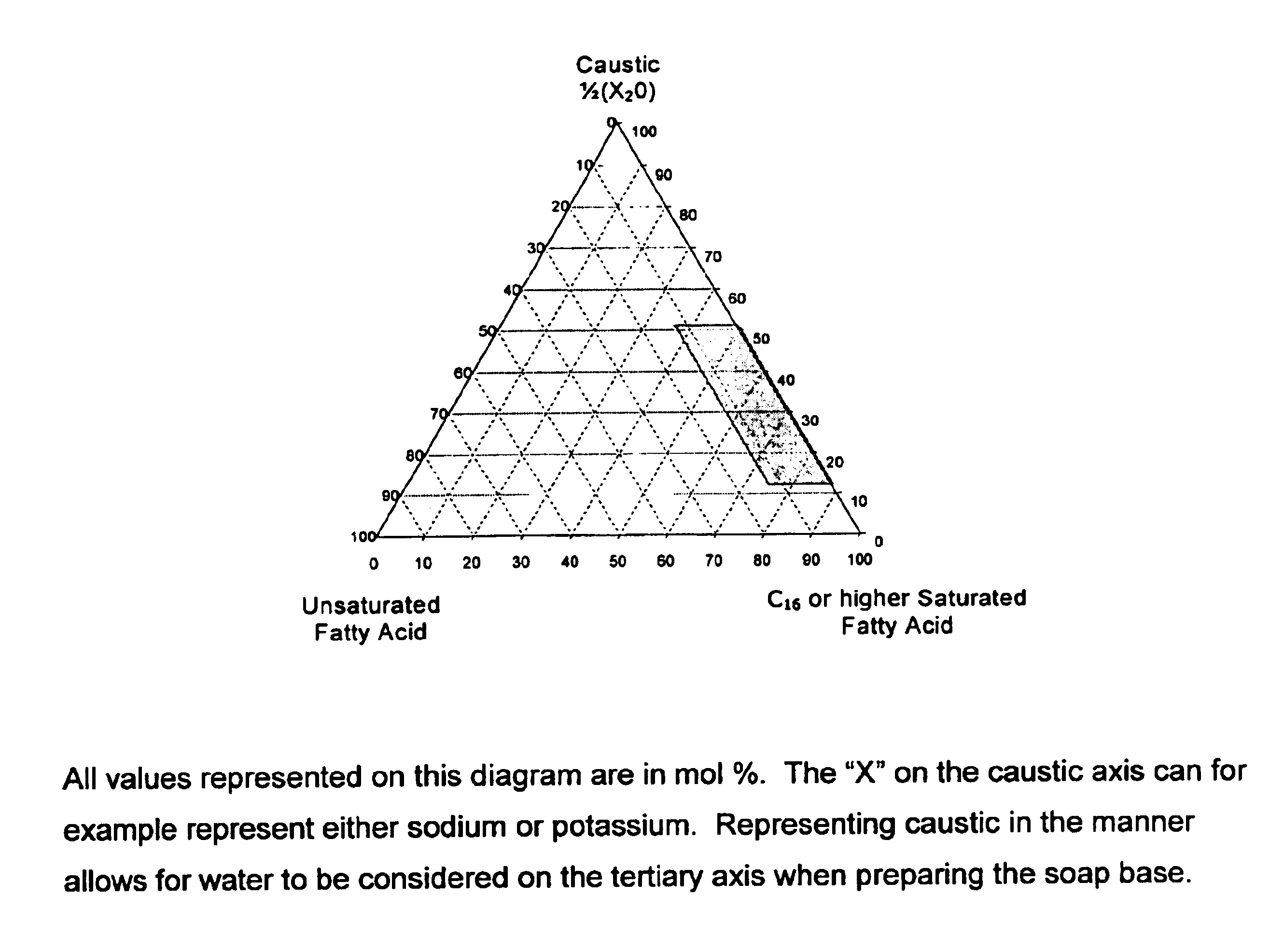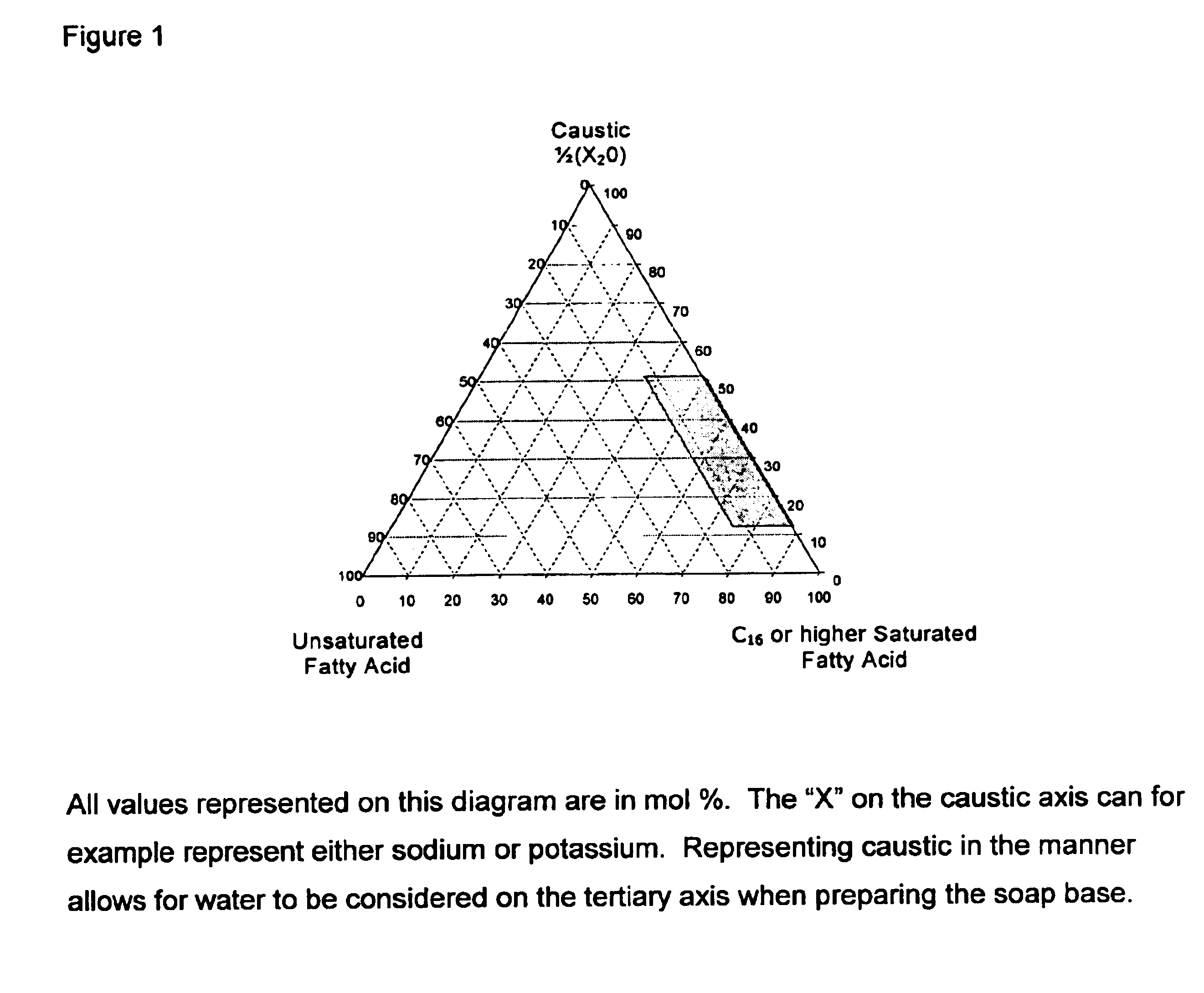Fatty acid soap/fatty acid bars which process and have good lather
a technology of fatty acids and soap, which is applied in the direction of detergent compositions, soap detergent compositions, chemistry apparatus and processes, etc., can solve the problems of harshness (e.g., non-mild) to the skin, harsh and drying,
- Summary
- Abstract
- Description
- Claims
- Application Information
AI Technical Summary
Benefits of technology
Problems solved by technology
Method used
Image
Examples
second embodiment
As noted, according to the invention, fatty acid can be combined with previously formed soap (rather than forming soap via neutralization) prior to combination with synthetic surfactant and other materials.
More specifically, the final bar compositions of the invention comprise:(1) 40% to 88% by wt. of a precursor or base bar composition which can be made either by combining fatty acid (having maximum amount of unsaturates and saturates substantially free of chain length C14 and below) and caustic; or by blending preformed soap and fatty acids (also with maximum amount of unsaturates and substantially free if C14 and below) without neutralizing.(2) 7% to 25% by wt. preferably 10% to 22% by wt. synthetic surfactant;(3) 5% to 15%, preferably 6% to 13% by wt. water, and(4) 0% to 20% by wt. filler (e.g., carbohydrates; waxes; emollients; salts such as carbonates, silicates; talc etc);wherein (1) is substantially free of C14 and below fatty acid soaps and free fatty acids; as is also the ...
example 1
Establishing Prototype Model
Applicants sought to design a model soap base (defining ternary structuring system of the invention) to which additional surfactants could be added. The idea was to define a combination (or range) of long chain saturated to unsaturated soaps that could be acceptable to act as soap bases to which other surfactants could be formulated into. Having at least some free fatty acid was desirable to impart mildness.
Using phase factors, applicants established a model where the axes are scaled as mol %.
In general the following observation was made with regard to level of caustic used and resulting levels of soap and fatty acids:(1) using 50 mol % caustic results in full neutralization (all soap and no free fatty acid);(2) 37.5 mol % caustic results in 3:2 ratio of soap to fatty acid;(3) 25 mol % caustic results in 1:2 ratio of soap to fatty acid; and(4) 12.5 mol % caustic results in 1:6 ratio of soap to fatty acid.
example 2
Bar Preparation
The mixer used in the preparation of the bar was a ploughshare mixer and a batch preparation was used. The procedure was to melt fatty acids (i.e., at temperature of about 65 to 105° C.), add caustic (to neutralize some or all free fatty acid), add surfactant, and remove at desired moisture. From the mixer, material was placed on 3-roll mill to quickly cool. Subsequent ribbons were extruded on a two-stage, single screw Mazzoni plodder.
PUM
| Property | Measurement | Unit |
|---|---|---|
| Fraction | aaaaa | aaaaa |
| Fraction | aaaaa | aaaaa |
| Fraction | aaaaa | aaaaa |
Abstract
Description
Claims
Application Information
 Login to View More
Login to View More - R&D
- Intellectual Property
- Life Sciences
- Materials
- Tech Scout
- Unparalleled Data Quality
- Higher Quality Content
- 60% Fewer Hallucinations
Browse by: Latest US Patents, China's latest patents, Technical Efficacy Thesaurus, Application Domain, Technology Topic, Popular Technical Reports.
© 2025 PatSnap. All rights reserved.Legal|Privacy policy|Modern Slavery Act Transparency Statement|Sitemap|About US| Contact US: help@patsnap.com


